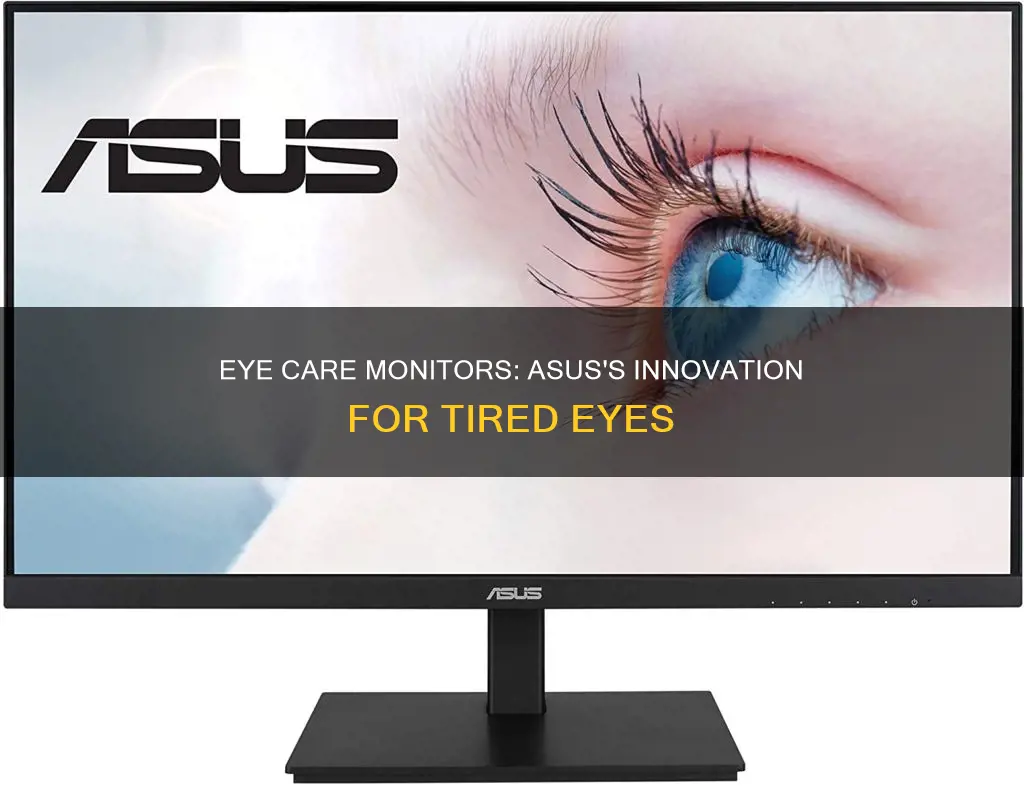
ASUS Eye Care monitors are designed to protect your eyes from prolonged exposure to screens, which can lead to Computer Vision Syndrome (CVS). This condition is caused by blue light emissions, display flicker, and glare, resulting in eye strain, headaches, and even sleep disorders. ASUS Eye Care Technology addresses these issues with its Blue Light Filter and Flicker-Free features, ensuring comfortable and safe viewing experiences. The technology also includes an Anti-Glare Screen, which uses a rough matte surface to reduce reflections and glare, further reducing eye strain. The monitors offer ergonomic designs with full tilt, pivot, swivel, and height adjustments for a natural and comfortable viewing position. ASUS Eye Care Plus Technology takes eye care a step further with additional features like Color Augmentation Mode, which assists those with color vision deficiencies. Overall, ASUS Eye Care Monitors aim to provide a comprehensive solution for eye health in today's digital world.
| Characteristics | Values |
|---|---|
| Purpose | To protect eyes from prolonged exposure to computer monitors, which can cause Computer Vision Syndrome (CVS) |
| Technology | Blue Light Filter, Flicker-Free, Smart Dynamic Backlight Adjustment, Anti-Glare Screen, EyeCheck, Rest Reminder |
| Blue Light Filter Levels | Level 0 (Standard Mode), Level 1 (Web Browsing), Level 2 (Viewing Photos/Videos), Level 3 (Reading/Word Processing), Level 4 (Dim Ambient Light) |
| Eye Issues Addressed | Eye Strain, Headaches, Sleep Disorders, Myopia, Macular Degeneration |
| Additional Features | Color Augmentation Mode, Adjustable Tilt/Pivot/Swivel/Height, Built-in Speakers, USB Ports, Webcam, Microphone |
What You'll Learn

ASUS Eye Care Technology
Understanding Computer Vision Syndrome (CVS):
CVS is a condition that arises from extended periods spent staring at digital screens. It is characterised by a range of unpleasant symptoms, including eye strain, headaches, and sleep disorders. The high-energy blue-violet light emitted by screens, known as blue light, is particularly damaging to the lens and retina of the eye, potentially leading to myopia and macular degeneration. Children are especially vulnerable to the effects of blue light due to their developing eyes.
How ASUS Eye Care Technology Helps:
- Blue Light Filter: ASUS Ultra-low Blue Light Technology protects your eyes from harmful blue light emissions. It offers four different filter settings (Levels 0-3) that can be adjusted according to your specific task, ensuring optimal eye comfort while browsing, viewing multimedia, reading, or working in low-light environments.
- Flicker-Free Technology: ASUS Flicker-Free Technology eliminates display flicker, which is caused by the LED backlight adjusting its brightness. This technology uses Smart Dynamic Backlight Adjustment to maintain consistent brightness and reduce eye fatigue, irritation, and strain.
- Anti-Glare Panel: The ASUS A+ Anti-Glare panel features a rough matte surface that reduces reflections and glare. This design prevents eye strain and fatigue by dissipating reflected light, making it easier to view the screen, especially in bright environments.
- Ergonomic Design: ASUS monitors are designed with full tilt, pivot, swivel, and height adjustments. This ergonomic design ensures that you can achieve a natural and comfortable viewing position, reducing the risk of eye strain associated with improper monitor placement.
Monitoring VRAM Usage: MSI Afterburner Guide
You may want to see also

Blue Light Filter
ASUS Eye Care Monitors are designed to protect your eyes from the negative effects of prolonged screen time. One of the key features of ASUS Eye Care Technology is the Blue Light Filter, which aims to reduce the impact of blue light emissions on your eyes.
Blue light, particularly in the 415-455nm band, is a type of high-energy blue-violet light that can be harmful to the human eye, specifically the lens and retina. Exposure to blue light can lead to eye strain, headaches, and even sleep disorders. It can also result in more serious issues such as myopia and macular degeneration. Children are especially vulnerable to the effects of blue light as their crystalline lens is less effective at filtering it out, increasing their risk of age-related macular degeneration.
The ASUS Blue Light Filter offers four different levels of blue light reduction to suit various tasks and ambient lighting conditions:
- Level 0 is the standard mode, which allows for excellent colour reproduction and minimal colour shift.
- Level 1 is ideal for normal web browsing, offering a balance between colour accuracy and blue light reduction.
- Level 2 is designed for viewing photos and videos, providing a perfect balance of high image quality while reducing blue light exposure.
- Level 3 gives you a display similar to real paper, making it ideal for long hours of reading or word processing.
- Level 4 is specifically for use in environments with low ambient light, optimising the display for blue light reduction.
The Blue Light Filter settings can be easily adjusted using the onscreen display (OSD) menu, allowing users to customise their viewing experience based on their specific needs. This technology helps ensure that users can work, play, or learn comfortably while reducing the potential harm caused by blue light emissions.
Taking Screenshots on Your ASUS Monitor: A Step-by-Step Guide
You may want to see also

Flicker-Free Technology
ASUS Eye Care monitors are designed to protect your eyes from the adverse effects of prolonged screen time. One of the key features of these monitors is Flicker-Free Technology, which addresses the issue of onscreen flicker caused by the rapid on/off cycle of LED backlights as they try to maintain brightness.
ASUS Flicker-Free Technology provides a comfortable viewing experience, allowing you to work, play games, or watch videos for extended periods without causing strain on your eyes. It is certified by TÜV Rheinland, a global provider of technical, safety, and certification services, ensuring that it meets the highest standards for reducing flicker and protecting your eyes.
With ASUS Flicker-Free Technology, you can trust that your monitor is designed with your eye health in mind, ensuring a more comfortable and enjoyable experience, even during long hours of screen time. This technology is just one of the ways that ASUS Eye Care monitors help to protect your eyes in today's digital world.
Monitoring Internet Usage: ASUS Router Settings Guide
You may want to see also

Anti-Glare Screen
The ASUS Eye Care Monitor features an anti-glare screen, which helps to reduce eye strain and fatigue. The anti-glare panel uses a rough matte surface to scatter light, reducing reflections and glare from natural or artificial light sources. This is especially beneficial for users who work in bright environments or spend prolonged periods in front of a display, as it helps to maintain screen visibility and reduces the risk of Computer Vision Syndrome (CVS).
An anti-glare screen is a type of display that uses a special coating or treatment to reduce reflections and improve visibility in bright environments. By scattering incoming light instead of reflecting it directly, anti-glare screens create a softer, more matte appearance compared to glossy screens. This diffusion effect helps to reduce harsh glare and improve comfort during extended screen time, making it easier to view the screen without straining the eyes.
The ASUS A+ Anti-Glare panel is designed to prevent unwanted reflections and glare, which can cause eye strain and fatigue. The matte surface of the panel effectively reduces glare and improves visibility, especially in bright environments with direct sunlight or fluorescent lighting. This feature ensures that users can work or play comfortably for extended periods without experiencing eye discomfort.
In addition to reducing glare, the ASUS Eye Care Monitor's anti-glare screen also offers other benefits. The matte surface is less prone to fingerprints and smudges, keeping the screen cleaner for longer. Additionally, the anti-glare treatment can improve colour accuracy and contrast in bright lighting conditions, providing a superior viewing experience.
While anti-glare screens offer these advantages, there are also a few potential drawbacks to consider. The diffusion of light may result in a slight reduction in overall screen clarity and sharpness, with text and images appearing slightly softer. Additionally, anti-glare screens may exhibit a subtle "sparkle" effect when displaying light colours, which can be distracting to some users. Moreover, anti-glare screens can impact touch sensitivity and may pose challenges when it comes to cleaning the screen effectively.
How TP-Link HS105 Monitors Your Energy Usage
You may want to see also

EyeCheck Function
The EyeCheck function is a built-in feature on ASUS Eye Care Monitors that allows users to check their eyesight at any time. Accessible via the monitor hotkey, EyeCheck provides users with eye charts for short- or long-sightedness. This feature is designed for visual reference only, and users experiencing eye discomfort are advised to consult a healthcare professional or ophthalmologist for treatment.
The EyeCheck function is part of ASUS's commitment to providing eye care solutions for its users. The company recognises that prolonged screen time can lead to various eye problems, including Computer Vision Syndrome (CVS). To address this issue, ASUS has developed Eye Care technology, which includes features such as adjustable blue light filters and flicker-free technology, to minimise eye strain and provide a comfortable viewing experience.
The adjustable blue light filter on ASUS Eye Care Monitors offers four different settings to suit different scenarios and user preferences. Level 1 is ideal for normal web browsing, providing excellent colour reproduction and minimal colour shift. Level 2 is perfect for viewing photos and videos, offering a balance between image quality and blue light reduction. Level 3 simulates the look of real paper, making it suitable for extended periods of reading or word processing. Finally, Level 4 is designed for environments with low ambient light, reducing blue light exposure while maintaining visibility.
In addition to the blue light filter, ASUS Eye Care Monitors also incorporate flicker-free technology to prevent eye fatigue, irritation, and strain. This technology eliminates the rapid on/off cycle of the LED backlight, reducing drastic changes in brightness that can cause eye strain and headaches. Together, the adjustable blue light filter and flicker-free technology help to create a more comfortable and healthy viewing experience for users, especially those who spend long hours in front of their computers.
Monitoring Home WiFi Usage: An Xfinity User's Guide
You may want to see also
Frequently asked questions
An ASUS Eye Care Monitor is a monitor designed with eye health in mind. It features exclusive Blue Light Filter and Flicker-Free technologies to reduce the risk of Computer Vision Syndrome (CVS) symptoms caused by prolonged periods in front of a display.
CVS is a condition that can be caused by factors such as blue light emissions, display flicker, and glare from screens. High-energy blue-violet light, in particular, can damage the human eye, leading to issues like myopia and macular degeneration. Blue light from monitors can also cause eye strain, headaches, and sleep disorders.
Onscreen flicker is caused by the rapid on/off cycle of an LED backlight as it adjusts its brightness. This constant change in light intensity causes the pupil to expand and contract, leading to eye fatigue, strain, and headaches.
ASUS Eye Care Technology helps prevent CVS and reduce eye strain by offering adjustable Blue Light Filter settings and Flicker-Free Technology. The Blue Light Filter has four levels to suit different tasks and lighting conditions, while the Flicker-Free Technology uses Smart Dynamic Backlight Adjustment to reduce flicker and provide a comfortable viewing experience.
ASUS Eye Care Monitors provide an extra layer of comfort and protection for your eyes, especially during extended screen time. They are designed to reduce eye strain, irritation, and fatigue, allowing you to focus on your tasks without the discomfort caused by glare and flicker. ASUS Eye Care Monitors are ideal for students, creators, and gamers who spend long hours in front of screens.







